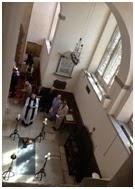Ray Anglesea shared this reflection with the congregation
of St Andrew's Dawson Street, Crook on October 12
of St Andrew's Dawson Street, Crook on October 12
Last
Thursday, 2nd October, at a meeting at Lancaster House, London,
Britain appealed for international help to contain the world’s worst outbreak of
the Ebola virus which is now spreading at the rate of five cases an hour in
Sierra Leone. Philip Hammond, the
foreign secretary, was joined at Lancaster House by representatives of five
African countries and ten other nations, including American and Cuba. UN
organisations, charities, Idris Elba the actor, and William Pooley, the British
nurse who recently recovered from Ebola, were also present.
The
Ebola virus has, at terrifying speed, killed almost 4,000 people. It has been
sweeping across vulnerable African states with such intensity that health
experts believe as many as 1.4 million people could be infected by next January
2015. The number of infections is doubling every three weeks. President Obama
has already described the disease as a “threat to global security.”
It
is perhaps difficult for those of us who live in a country where there are 270
doctors per 100,000 of population to imagine what it is like for those living
in Sierra Leone where there are only 3 doctors for the same number trying to
deal with such a highly contagious disease. It is not therefore surprising that
people look for meaning where there seems to be none, and that they turn to
tried and tested ideas about God’s punishment, drawing parallels with the
plagues of Egypt, blaming particular social groups and claiming that only those
protected by God’s hand will be “delivered.”
In the Bible there are plenty of examples of
such connections being made between sickness and sin, and even amongst the
generally agnostic population of this country, sudden disease or injury can
make us ask why and look for reasons in our own behaviour, rehearsing our
regrets about the past and bargaining with God about the future. But, although
there may be times when a period of illness or some other crisis can prompt us
as individuals, or even as nations, into important thinking about the meaning of
our lives, and even into turning away from behaviours which do us and others no
good, there is a world of difference between finding the strength to change our
own ways through a shock we have received, and vulnerable groups being told by
authority figures that they are sick because they are immoral or because God is
angry with them.
Such pronouncements may bolster the moral
certainties of those who make them, but for those unfortunate enough to fall
ill in a poor country through no fault of their own, fast on the heels of the
terror of being sick, comes stigmatisation, isolation and the withdrawal of all
kinds of help. In the ministry of Jesus, rather than withdrawing from those who
were sick or socially outcast, he was constantly crossing boundaries to reach
out to people, whether they were lepers who were contagious and considered
unclean or haemorrhaging women who had exhausted all their funds on doctors who
could not help, or even the morally dubious by the conventions of the time.
Those who are in the field in West Africa fighting this disease - both Christians and others - deserve our support as they contribute to the fight this disease. Save the Children at Thursday’s conference pledged £70 million of which £40 million is for work in Sierra Leone. Comic Relief has pledged £1 million whilst the UK government has put £125 million into the pot to fight Ebola, including the promise of 700 extra beds in hospital units constructed under the supervision of the military. Four hundred NHS staff have volunteered to help staff them and train local people.
Those who are in the field in West Africa fighting this disease - both Christians and others - deserve our support as they contribute to the fight this disease. Save the Children at Thursday’s conference pledged £70 million of which £40 million is for work in Sierra Leone. Comic Relief has pledged £1 million whilst the UK government has put £125 million into the pot to fight Ebola, including the promise of 700 extra beds in hospital units constructed under the supervision of the military. Four hundred NHS staff have volunteered to help staff them and train local people.
To
me, it is clear that if God is to be found in the Ebola outbreak, he is not in
the scapegoating of particular social groups, but is alongside those who are
the disease’s victims, and embodied in those brave people who take risks to
help.
Ray Anglesea
Ray Anglesea































